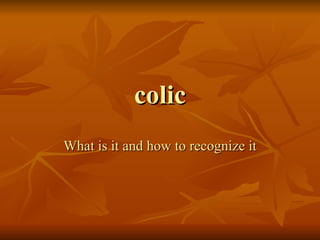Colic
- 1. colic What is it and how to recognize it
- 2. What is Colic The term colic comes from a Greek root and refers to the Colon and the later part of the Large intestine .The term in modern times refers to a general pain in the abdomen.There are many causes for colic ranging from mild to life threatening or fatal.
- 3. Where does that food go? The horse G. I. Tract helps to explain why there are so many forms of colic.The horse GIT is similar to that of other species but it has a number of specialized design features,some of which predispose it to colic.
- 4. A tour of the GI Tract Once food has been chewed it passes down the esophagus into the stomach( 8-5 liters) After a period of digestion the food passes into the small intestine.This part of the gut is approximately 22 meters long with a diameter of 7-10 cm and has a capacity of 40-50 liters Most of the small intestine hangs from a curtain like membrane called the mesentery*. At the junction of the small intestine and the large intestine is blind ended pouch called the caecum,it is over one meter long and has a capacity of 25-30 liters the Caecum is the horses version of the appendix.Food passes from the small intestine into the Caecum and then into the large intestine
- 5. A tour of the GI Tract The caecum and the large intestine form the horses fermentation chamber allowing it to gather nutritional values from grass and forage.The large intestines 3-4 meters long diameter of20-25 cm and can hold 50 liters,the large intestine fills a large part of the abdomen. This structure is attached to the body at only two places*,at its beginning and at its end.With only two immobile spots the intestine lies in the abdomen in a neatly arranged double u formation one u stacked on top of another. This arrangement entails the food having to go around number of 180 bends known as flexures.
- 6. Signs of colic Lying down more than normal Getting up and lying down repeatedly Turning head towards there flank Abnormal sweating Pawing the ground Kicking at the stomach Rolling Curling the upper lip Flanks tucked up A poor look in the eye Gums a pale color with a slow C.R.T
- 7. Types of colic's Impacted colic Is the term used when the the intestines become blocked by a firm mass of food or manure. This is a fairly common type of colic but could also be the start of a more complicated case. Flatulent Colic Sometimes gas builds up within the intestine most commonly in the large intestine and the caecum .The gas stretches the intestine wall causing pain.
- 8. Types of Colic Spasmodic Colic Some cases of colic are due to increased intestinal contractions and abnormal spasms cause the intestine to contract painfully. Twisted Gut This is mostly a result of a more benign type of colic and is a displacement of a portion in the abdomen. The large unfixed portions of the large intestine predisposes horse to this problem.
- 9. What do I do ? The severity of the case will dictate what you do and when .Not all horses show the same symptoms in the same way and in the same order. If possible take T.P.R. Has the horses water intake been normal What frequency has the horse defecated if any Are the gums normal check C.R.T. With all this information call the Vet
- 10. What do I do ? Remove any hay or food from the stable. If possible walk Do Not Let The Horse Roll . Do not give any medication unless advised by the vet some medications can hide more serious symptoms.










